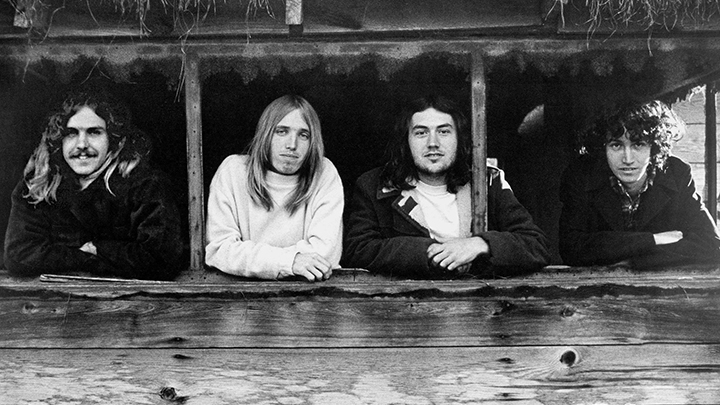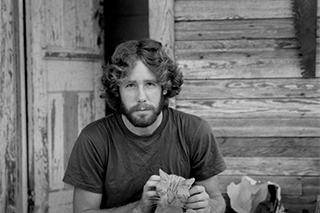Envision Alumni Edition Fall 2018
Red Slater ‘81 Chronicled Early Days of Musician Tom Petty’s Career
By Brad Stager
All photos courtesy of Red Slater

During a pause in his academic pursuits, College of Engineering alumnus William "Red" Slater took up residence with a couple of musician friends in a farmhouse sitting on ten acres of fertile Florida soil, north of Gainesville. Now the site of a suburban housing development, in the late 1960s and early 1970s it was a piece of the college town's music scene. The farm provided rehearsal space and a place to hang out for an aspiring musician named Tom Petty and his bandmates, including Slater's friends, guitarist Mike Campbell and drummer Randall Marsh. The sound the musicians produced was like no other around so they gave great thought to a name for their band that would reflect as much and came up with Mudcrutch. According to Slater, the band's name quickly became strongly associated with the property.
"Actually, Tom and others dreamed up the name, and after the first festival the house and land became known as 'Mudcrutch Farm,' or just 'the farm' to the band and friends," Slater writes in an email.
The farm, with its remote location and on-site social activities, became a music venue as much as a home, hosting large music festivals and serving as an incubator to what eventually became Tom Petty and the Heartbreakers, one of contemporary music's most successful performing acts. Slater, who had a 35-millimeter camera and a home darkroom to process black and white film and prints, captured it all for Rock and Roll history. The pictures he took illustrate the genesis of Tom Petty and the Heartbreakers in articles, books, videos and also films such as director Peter Bogdanovich's movie, "Runnin' Down a Dream."

Slater's black and white photographs of the musicians and their friends document Gainesville's vibrant music scene of the time and show a workmanlike approach to the job of playing music and the joy of being around like-minded folks, such as when Mudcrutch and another band, Road Turkey, teamed up for what must have been, from what can be discerned from the smiles Slater captured with his camera, the most fun picnic of all time. The group photo of that picnic, which illustrates the cover of the book "Music Everywhere: The Rock and Roll Roots of a Southern Town," shows Slater's wife Linda holding their six-month-old daughter on the right.
A consistent element of Slater's photography is using only the light available to illuminate a scene, however dim it may have been during late-night rehearsals.
"I've always eschewed flash," says Slater. "It's all natural light."
Developing the film and printing the photographs in his farmhouse darkroom required a hands-on approach, says Slater, when comparing working in a traditional wet darkroom to creating and editing photos digitally with software.
"It's more visceral. You have your fingers in the developer when you put the print in there, and you're attached to it. The first time you see a print come out and develop right before your eyes under a safelight is pretty amazing."
While the significance of his photographs are apparent now, receiving new interest with the passing of Petty from cardiac arrest in October, that wasn't the case back when Slater took the pictures.
"I was taking pictures of everyone, there were a lot of bands around Gainesville and I took pictures of whatever was happening," says Slater, who received his bachelor's in electrical engineering from USF in 1981.

The Tampa campus that Slater attended and now recalls sounds quite different from the university's 21st Century landscape.
"There was a lot of land on the campus at that time for expansion," says Slater, who had enough credits from other schools to enroll at USF as a junior and like most of the students at the time, commuted to the university for classes and did not otherwise spend much time there.
"I was a "drive-in" student. I lived in San Antonio, Florida, and I'd drive down to class, do my class time and unless I had another one coming up soon, I'd just drive back home."
While there wasn't much reason for Slater to stick around campus after classes, he found it easy to make efficient use of his time when he did.
"It was convenient and it was a good choice. I liked USF. It was easy to get in to see professors and I would even talk to the dean occasionally."
Slater, who worked at many jobs, including photography, carpentry and social work between his Mudcrutch Farm days and graduation from USF, says he had a firm idea as to how he wanted to apply his engineering knowledge and skills.
"I wanted to go into the utility business and make my career there, so I had my mind pretty much made up that I was going to try and get a job at Florida Power (now Duke Energy), and that's where I started and spent my whole career."
That career lasted 25 years, working mostly in the utility company's Tampa Bay area Energy Control Center, keeping an eye on the flow of energy through the electrical grid into homes and businesses.
"My job and the job of most of the people there was to look after the reliability of the transmission grid so we don't have a rolling blackout or something," says Slater, who characterizes the operation center's routine as one without a lot of workplace glamor, though it could get interesting at times.
"Working in the operations center, the pressure always comes up when you're having to deal with hurricanes. It's a pretty dynamic situation. There are massive outages and you're trying to coordinate with everybody about how to bring the grid back up."
After Slater retired he and his wife Linda eventually moved to North Carolina where photography still occupies his interest and time. You can see a gallery of some of his work here http://www.cameraclubofhendersonville.com/p885954896 and many of his early photographs of Petty and his band, daily living on Mudcrutch Farm and playing music in Gainesville can be found illustrating websites related to Tom Petty and the Heartbreakers and the band Mudcrutch.
To learn more about the mid-20th Century music scene in Gainesville, Marty Jourard's book, "Music Everywhere: The Rock and Roll Roots of a Southern Town," tells that story and uses many of Slater's photographs to do so.